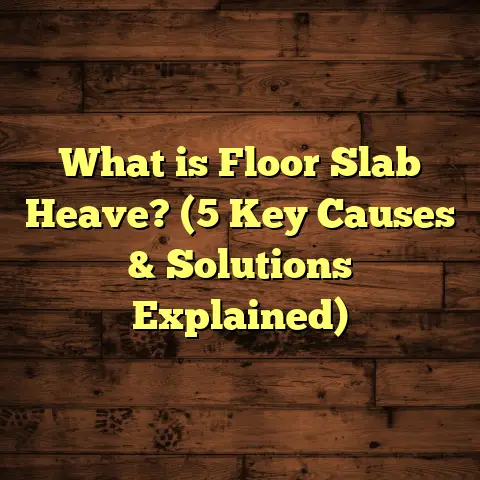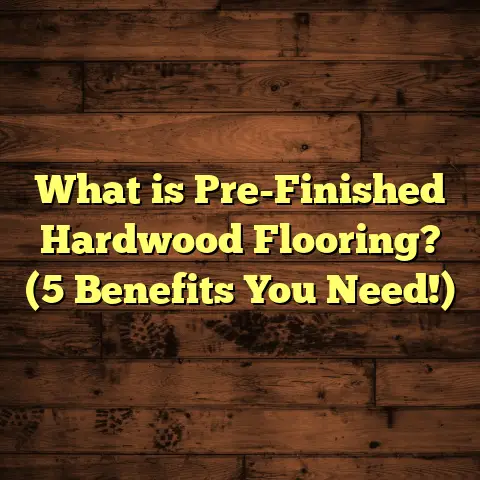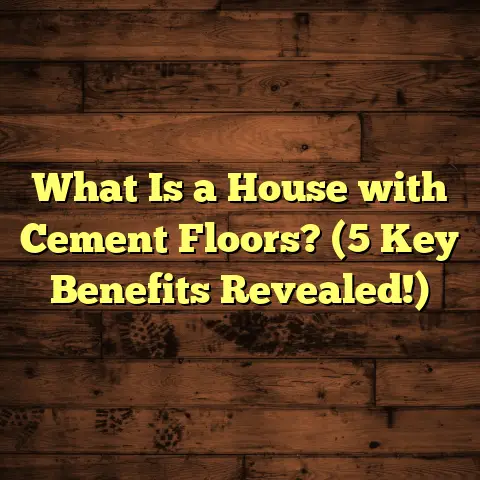What is the Difference Between Laminate and Wood Floors? (5 Key Insights for Homeowners)
Have you ever stepped into an old family home and felt that comforting warmth beneath your feet? Maybe it was the soft creak of wooden planks or the smooth finish that made you want to kick off your shoes and sink into the moment. Those memories have stuck with me over the years. They often come back when I’m talking to friends or clients about flooring choices. Flooring isn’t just a practical necessity—it’s part of how a home feels.
I’ve spent over 15 years working as a flooring contractor, helping homeowners decide between laminate and wood floors. Both have their place, but they’re very different under the surface. I want to share what I’ve learned through hands-on work, hours of research, and conversations with homeowners all over the country.
If you’re thinking about new floors for your home, stick with me. We’ll cover what makes laminate and wood floors unique, how they wear over time, costs you can expect, installation realities, and maintenance demands. Plus, I’ll drop in some personal stories and data-backed insights you won’t find in a quick online search.
What Does It Mean When We Talk About Laminate and Wood Floors?
Let’s start by defining what we mean when we say “laminate” or “wood” floors. Understanding these basics makes it easier to decide which flooring fits your life.
Laminate Flooring: A Closer Look
Laminate is a man-made product designed to imitate wood and other natural materials. It’s built in layers:
- Core Layer: Usually made of high-density fiberboard (HDF) or medium-density fiberboard (MDF). This gives laminate its strength.
- Design Layer: A high-resolution photographic image that mimics wood grain patterns or stone textures.
- Wear Layer: A transparent top coat made of melamine resin that protects from scratches, stains, and fading.
The manufacturing process chemically bonds these layers under heat and pressure, forming durable planks that click together during installation.
Laminate boards typically range in width from 6 to 9 inches and length from 36 to 48 inches. Thickness varies from 6mm to 12mm, with thicker boards often feeling more substantial underfoot.
Wood Flooring: What Are You Getting?
When people say “wood floors,” they usually mean hardwood—natural planks cut from trees like oak, maple, walnut, or cherry.
There are two main types:
- Solid Hardwood: These are single pieces of wood, generally 3/4 inch thick. They can be sanded and refinished multiple times over decades. Traditional solid hardwood is nailed or stapled down to a wooden subfloor.
- Engineered Hardwood: Made of several layers—usually three to ten—of wood veneers glued together with the grain running in alternating directions. The top layer is solid hardwood (often 2-6mm thick). This construction makes engineered hardwood more stable in humid or fluctuating climates. It can be installed as a floating floor, glued down, or nailed.
Plank widths for hardwood vary widely—from narrow strips of 2 1/4 inches up to wide planks over 7 inches.
Why Does This Matter?
Knowing these differences helps understand why laminate and wood behave so differently when installed in your home.
Laminate’s synthetic core resists dents better but doesn’t handle moisture well. Hardwood offers natural beauty and long life but requires more care and can be damaged by heavy wear or water.
1. Appearance: Can Laminate Match Real Wood?
I remember early in my career installing laminate floors that looked like cheap imitations. But technology has changed dramatically since then.
The photographic layer on modern laminate uses ultra-high-definition images combined with texture embossing to simulate real wood grains. For example, I recently installed a laminate floor from Quick-Step’s “Impressive” collection in a client’s Portland home. The boards had a hand-scraped texture that almost fooled me until I touched them.
Still, there are subtle giveaways:
- Uniformity: Laminate repeats patterns because it’s printed. Real wood planks are unique—no two boards have the exact grain or color.
- Edges: Real hardwood boards often have beveled edges that create small grooves between planks; laminate sometimes has this but not always.
- Feel: Laminate usually feels harder and colder underfoot unless installed with padding.
Personal Story: The “Wow” Factor
A couple in Denver wanted a rustic look but were budget-conscious. They picked laminate flooring that looked like distressed hickory with wide planks (7 inches). When their friends came over, many thought it was real wood until they learned otherwise.
The couple loved how much character the floor brought without the high price tag of hardwood. That project taught me laminate’s visual appeal has come a long way.
Real Wood’s Timeless Look
Hardwood flooring ages beautifully. The patina changes with time—some colors deepen while grain patterns become more pronounced. This natural aging process adds character that laminate can’t replicate.
Also consider stains and finishes: Hardwood can be sanded and re-stained in different colors over its lifespan—a flexibility laminate lacks.
Data Point on Preferences
According to a 2023 survey by Houzz:
- 74% of homeowners prefer real wood floors for their natural beauty.
- 18% prefer laminate mostly for cost savings and ease of maintenance.
- The rest choose tile or vinyl for other benefits.
So if you care about authentic appearance and lasting beauty, hardwood often wins out—but laminate can come surprisingly close at a fraction of the cost.
2. Durability and Lifespan: Which Floors Last Longer?
I often get asked how long laminate lasts compared to wood floors. The answer depends on use, environment, and care.
Laminate Durability
Laminate’s melamine wear layer makes it highly scratch-resistant—great for homes with kids or pets. It resists fading from sunlight better than many hardwood finishes.
I had a client from Austin install Pergo Outlast+ laminate in their kid’s bedroom back in 2018. After five years of jumping, spills, and toys rolling around, the floor showed minimal wear.
But there’s a catch: laminate doesn’t handle moisture well. If water seeps into seams or underneath, the fiberboard core swells and warps quickly.
Basements and bathrooms are risky places for laminate unless you use specialized waterproof products like COREtec Plus or AquaGuard lines.
Hardwoods Stand the Test of Time
Solid hardwood floors can last over 100 years if maintained properly. You can sand and refinish solid wood multiple times (usually every 7-10 years depending on wear), restoring their original appearance.
Engineered hardwood has a shorter lifespan—usually 20-40 years—because its top veneer is thinner and can only be refinished once or twice.
Here’s a quick durability chart:
| Flooring Type | Scratch Resistance | Moisture Resistance | Longevity |
|---|---|---|---|
| Laminate | High | Low | 10-25 years |
| Solid Hardwood | Medium | Medium (needs care) | 30-100+ years |
| Engineered Hardwood | Medium | Higher than solid | 20-40 years |
Environmental Factors Matter
In humid climates like Florida or Louisiana, engineered hardwood often performs better than solid wood because it resists warping caused by moisture fluctuations.
For dry states like Arizona or New Mexico, solid hardwood tends to stay stable if humidity is controlled inside the home.
3. Installation: How Much Work Is Involved?
This is where many homeowners start thinking practically: How much time and skill will my flooring need?
Installing Laminate: Fast and Friendly for DIY
Laminate flooring is usually installed as a floating floor where planks snap together without glue or nails. This saves time and tools—and makes it more accessible for DIYers.
For a typical room around 200 square feet:
- A homeowner with basic skills can install laminate in 1-2 days.
- Professionals might do it even faster—often within a day.
You also need underlayment (foam or cork) beneath the boards to reduce noise and cushion impacts.
I’ve helped many friends install their first laminate floors on weekends. One friend in Portland finished their entire living room (about 350 sq ft) in just two days using a click-lock system.
Hardwood Installation: Professional Skills Needed
Installing solid hardwood is more complex:
- The wood must acclimate in your home for at least 3-7 days before installation to prevent expansion/contraction issues later.
- Installation usually involves nailing or stapling boards down to a wooden subfloor.
- You may need sanding after installation to smooth joints.
This process takes longer—typically 3-5 days for an average room—and requires professional tools and experience.
Engineered hardwood installation varies depending on method:
- Floating floors can be DIY-friendly.
- Glue-down or nail-down require professionals.
Example: Installation Timeframes
In my experience working in Chicago:
- Laminate installation (300 sq ft): ~1 day by professionals; $600-$1,200 labor cost.
- Solid hardwood installation (same size): 3 days; $1,200-$2,400 labor cost.
- Engineered hardwood floating: around 2 days; labor $800-$1,500.
The subfloor condition matters too—uneven or damaged subfloors add time and costs for preparation.
4. Cost Breakdown: What Will You Pay?
Budgeting is a huge factor when choosing flooring. Here’s what to expect based on my projects across various states:
Material Costs
| Flooring Type | Cost per Sq Ft (Materials Only) |
|---|---|
| Laminate | $0.90 – $3 |
| Solid Hardwood | $3 – $10+ (depending on species) |
| Engineered Hardwood | $3 – $7 |
For example:
- Oak hardwood runs about $4-$6 per sq ft.
- Exotic woods like Brazilian cherry push $8-$12 per sq ft.
- Mid-range laminate brands like Pergo or Quick-Step usually cost $1.50-$2.50 per sq ft.
Installation Costs
Installation is roughly:
- Laminate: $2-$5 per sq ft
- Solid hardwood: $4-$8 per sq ft
- Engineered hardwood: $3-$6 per sq ft
Total Project Cost Example
For a standard living room (500 sq ft):
| Flooring Type | Material Cost | Installation Cost | Total |
|---|---|---|---|
| Laminate | $750 – $1,500 | $1,000 – $2,500 | $1,750 – $4,000 |
| Solid Hardwood | $1,500 – $5,000 | $2,000 – $4,000 | $3,500 – $9,000 |
| Engineered Hardwood | $1,500 – $3,500 | $1,500 – $3,000 | $3,000 – $6,500 |
You can see laminate offers big savings upfront but may not add as much resale value as solid wood.
Hidden Costs
Don’t forget extras like:
- Removal of old flooring ($1-$3 per sq ft)
- Subfloor repairs
- Moldings and trim
- Delivery fees
- Waste factor (usually add 5–10% extra material)
5. Maintenance: What Does Each Floor Demand?
Once installed, how much effort will you spend keeping your floor looking good?
Laminate Cleaning Tips
Laminate is easy to clean—just sweep regularly and mop with a damp cloth (not soaking wet). Avoid abrasive cleaners because they can dull the wear layer.
Spills should be wiped up quickly to avoid water damage at seams.
Repairing scratches is tough; small chips often require replacing boards sections because you can’t sand laminate.
I once had clients from Dallas call me because their pet scratched up the floor badly—they ended up replacing some planks but were pleased overall with durability elsewhere.
Hardwood Care
Hardwood floors need gentle cleaning with pH-neutral wood floor cleaners or damp mopping. Avoid excessive water to protect finishes.
Refinishing every decade or so maintains appearance by sanding away scratches and applying fresh coats of finish.
If scratched deeply or dented severely (like heavy furniture drops), boards can be repaired or replaced individually.
Environmental Impact & Sustainability
If you care about eco-friendliness:
- Wood floors can be sustainable if sourced from responsibly managed forests certified by FSC (Forest Stewardship Council).
- Laminate uses synthetic materials but often includes recycled content; however, it’s less biodegradable than wood.
Some manufacturers offer low-VOC finishes and adhesives that improve indoor air quality for both products.
Additional Insights From My Experience
Case Study: Family in Seattle
A family wanted durable floors in their high-traffic kitchen/dining area but also wanted warmth underfoot for their toddlers playing on the floor daily.
After discussing options:
- They chose engineered hardwood with a scratch-resistant finish.
- Installation took four days including prep.
- Cost was about $6,000 for materials + labor on a 350 sq ft space.
Two years later, they’re happy with how the floor has held up against spills and foot traffic while maintaining elegant looks—a balance between durability and beauty they appreciated.
Troubleshooting Common Problems
I’ve seen issues arise often with both flooring types:
Laminate problems:
- Swelling from water leaks.
- Gaps between planks due to poor acclimation before install.
- Fading if exposed to direct sunlight continuously without UV protection.
Wood floor problems:
- Cupping or crowning caused by moisture imbalance.
- Scratches/dents from heavy furniture.
- Squeaky floors from loose nails or subfloor movement.
Prevention through proper installation practices like moisture barriers helps avoid many headaches.
Wrapping Up Your Decision-Making Process
Now that we’ve covered appearance, durability, installation ease, costs, maintenance demands, and some real-life stories—what feels right for you?
Do you want quick installation with budget-friendly pricing? Laminate may suit you well, especially if you want good looks without too much fuss.
Do you want something that feels authentic underfoot with potential to last generations? Solid hardwood may be worth the investment despite higher upfront costs and more care needed.
Or maybe engineered hardwood grabs your interest by combining real wood surfaces with some moisture resistance and easier installation options.
Whatever your choice, knowing exactly what you’re getting helps avoid surprises down the road. If you want precise budgeting based on your home size and location, consider using tools like FloorTally—they pull local labor rates into estimates so you plan smarter from day one.
Got questions on brands? Installation tips? Feel free to reach out—I’m always happy to help friends pick floors they’ll love walking on every day!
(End of extended article)





